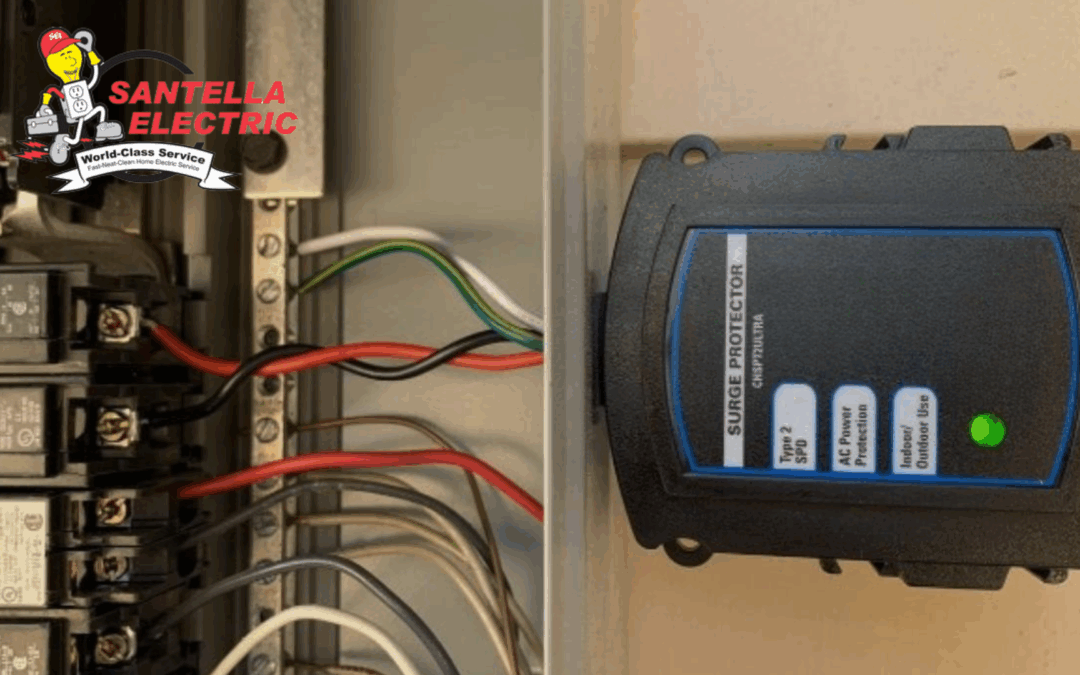Surge Protectors – An Introduction
While your home’s electrical system can help light up a room, there are plenty of dangers associated with it as well. As such, multiple products have been developed to enhance safety and protect your appliances when harnessing high voltage including the famed surge protector.
Coming in sizes for both individual outlets and for entire houses, surge protectors can be a vital point of protection against high-voltage spikes. Surge protectors will block/redirect excess current to protect your electronics, your home, and you from these potentially dangerous situations. Surge protectors are truly a must-have in the modern world. Here is how what sits inside a surge protector to make them work:
Santella Electric Co, Inc.
The BEST QUALITY, ON-TIME Electrical Service & Repair Company in Fairfield County
Santella Electric is an electrical service and repair company servicing Fairfield County, CT. We have over 55 years servicing our local area, and we are owner operated.
We Offer
24/7 Emergency Services
Schedule A Service Call
Components of a Surge Protector
Even if you’re familiar with a surge protector, many people are unaware of what pieces are inside and how they work. There are four major components to a surge protector:

Metal Oxide Varistor (MOV)
The MOV is a feature in many common types of surge protectors. Here, the MOV is responsible for diverting extra voltage to some of the other features we see below, mainly the grounding wire. For normal use with regular voltage, the MOV sits and waits. Essentially a pressure-release valve, the MOV doesn’t activate until the current has exceeded normal operations where it’ll then provide essential relief.
Thermal Fuse
Surge protectors, at the same time, are equipped with a thermal fuse that can serve as a shutdown feature for the protector when a surge becomes too much. As the MOV deals with the surge, sometimes the voltage can overwhelm. This increase in heat and power causes the thermal fuse inside to burn out, stopping the flow of electricity all the way through. A thermal fuse serves as a shutoff switch when surge becomes too much for the MOV.
Grounding Wire
While the MOV is able to conduct excess electricity when a surge happens, this excess energy still needs to go somewhere. To properly contain this extra voltage, the grounding wire serves as the solution. This system is able to short extra energy out of the circuit making the system safe in the face of surges.
Indicator Lights
Surge protectors can come with a number of lights that can help indicate the status and functionality of the system. On/green will mean that the surge protector is fully functioning and ready to conduct. Off/red means there are issues receiving power or potentially that a surge has occurred that caused internal damages to the protector.
Surge protectors sometimes come with grounded lights as well, which easily display whether or not the surge protector is properly grounded in the case of a voltage spike. Having proper grounding is fundamental to the operations of a surge protector. Anytime a surge protector is indicating something negative, it’s not safe to continue using should a surge occur.
Become A Safety Club Member
We offer our customers the peace of mind by being part of our maintenance program, a Safety Club Member. This program provides an annual safety home inspection each year you are a member in addition to the benefits of:

When In Doubt, Call an Expert
Never work on your home’s electricity without proper training. For whole home surge protector installation or troubleshooting current surge protections, a trained, licensed professional is the best way to produce long-lasting, safe results for your home. Experts like those at Santella Electric have years of electrical experience to help create a safe, surge-protected environment for you to thrive in. Call today to get scheduled!

Whole Home Surge Protector FAQs
Is it worth getting a whole house surge protector?
Many people find that a whole house surge protector gives them great peace of mind in their home. With vital protections for all appliances, including the larger expensive ones, whole house surge protection is a great insurance against large, unexpected surges.
Can I install a whole house surge protector myself?
No one should perform electrical work without a valid license and proven electrical experience. This ensures that the system is installed/works properly while protecting you from dangerous shocks that come from inexperienced hands.
Is surge protection necessary for a home?
With most modern homes filled with a variety of fragile electronics that we hold dear, surge protection is definitely a necessity for most. Prevent costly damages and increase your peace of mind with surge protectors standing guard against any harmful voltage spikes in your home.
How much would it cost to install a whole house surge protector?
Depending on what make and model of whole house surge protector you opt for, many of these products can be installed into your home for anywhere between $300 and $800 including both parts and installation. Compared to the potential money saved from frying expensive electronics in a surge, getting your whole house protected should be a no-brainer!



Recent Comments